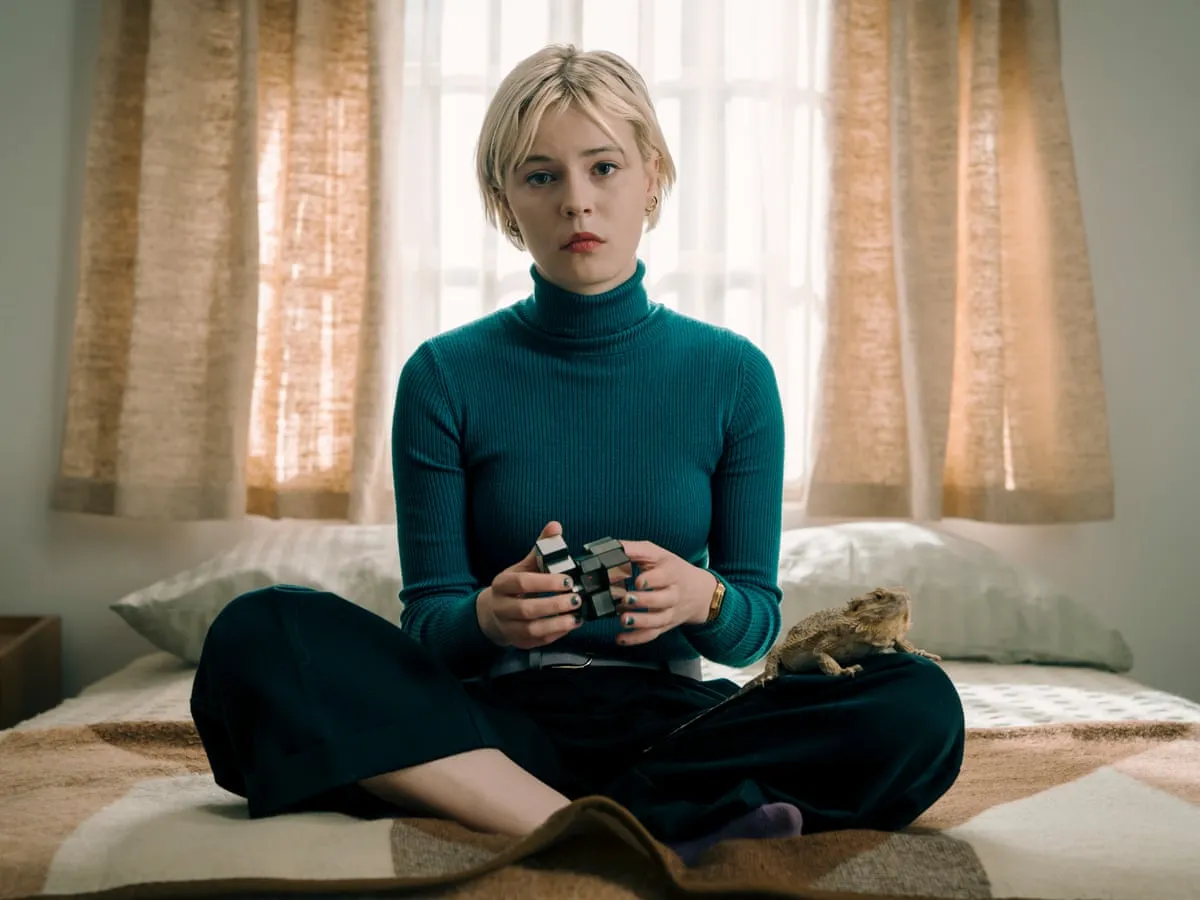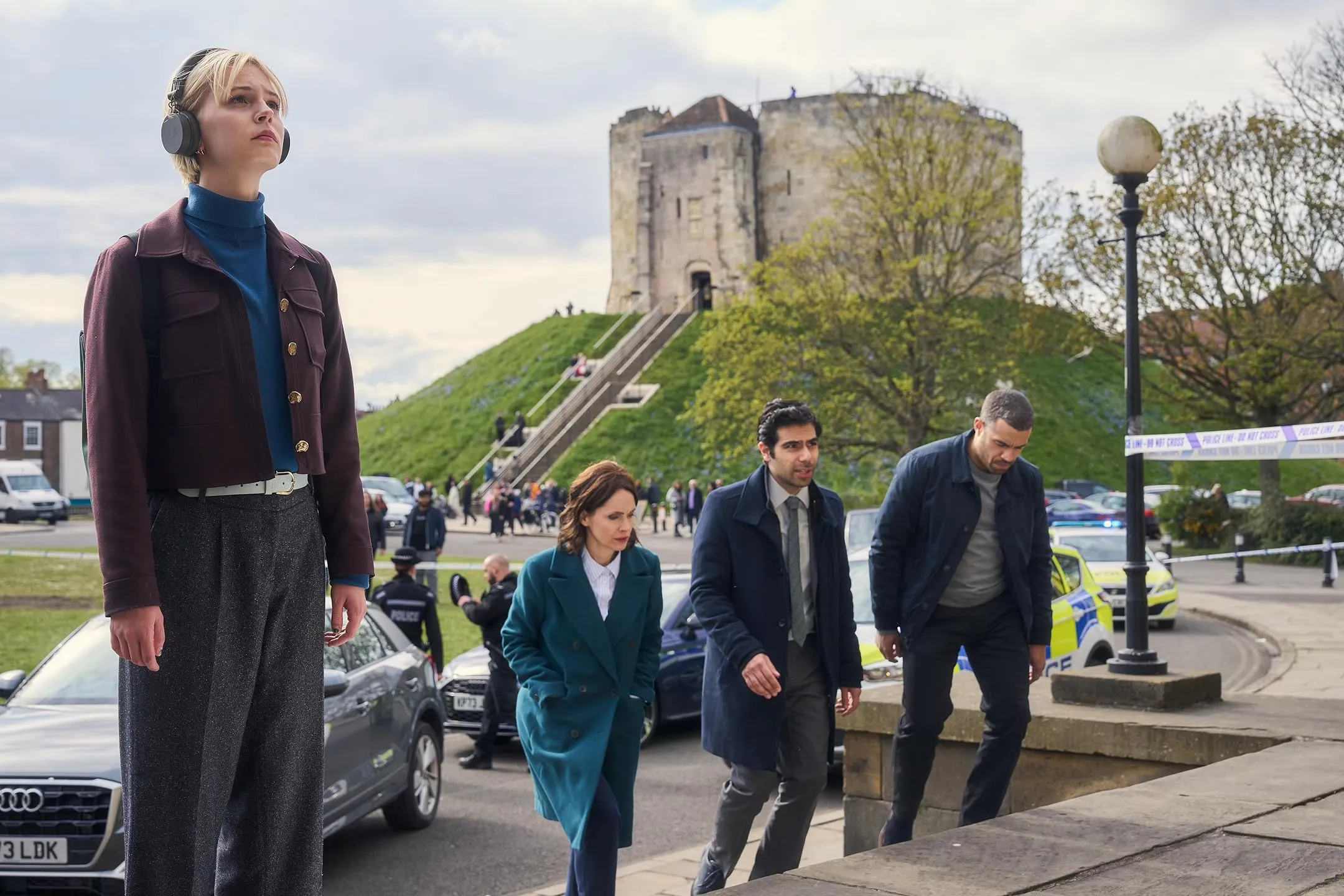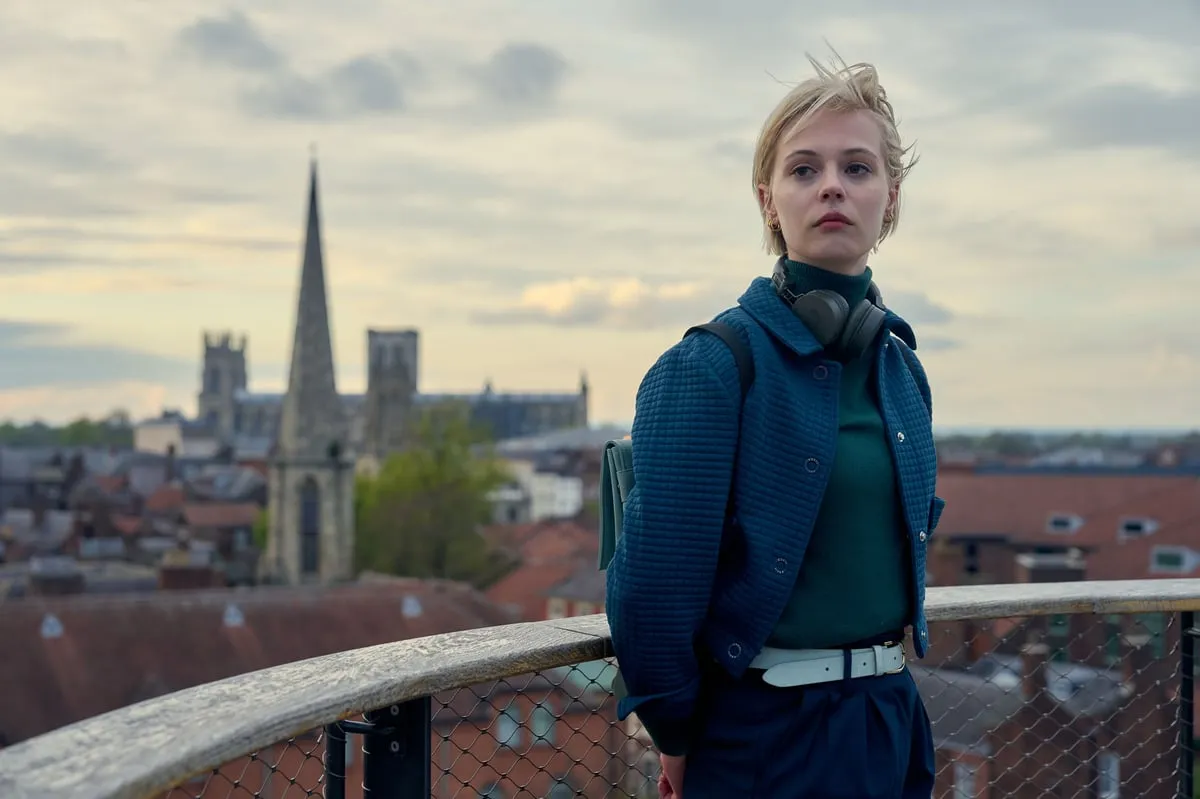In “Patience,” a young autistic cataloger named Patience Evans (Ella Maisy Purvis) and Detective Inspector Bea Metcalf (Laura Fraser) form a partnership that transports viewers to a world where the every day and the supernatural are intertwined. Patience is stuck in her empty archive, which you could call a “bureaucratic purgatory.” She has amazing pattern-spotting skills that aren’t being used. When Metcalf, a crazy detective, finds out about her skills, she and he are thrown into a series of strange investigations, starting with a man’s mysterious suicide.
This partnership reflects the larger societal commentary on neurodiversity. Metcalf represents the chaos of modern motherhood and work goals, while Patience’s problems with social interaction show the pressures of fitting in. They both question the usual ways of defining competence and success.
The series reflects the disorderly nature of its investigations with its absurdities, such as drugs that make people more easily persuaded. It raises the question of whether or not we, as a society, overlook the quieter narratives of those who live their lives differently. As we watch “Patience,” we think about the mystery being solved and the cultural effects of how we see and understand neurodiversity.
Navigating the Spectrum: Character Dynamics in “Patience”
Patience Evans, played by Ella Maisy Purvis, is a young autistic woman studying opposites. She is very good at recognizing patterns, which is also her weakness. Patience has to make her way through the maze-like halls of her police archive, which is literally a “paper mountain” (a term that could be used to describe the bureaucratic mess of society itself), in a world that values extroversion and social ease.
The careful routines, discomfort with touch, and reliance on headphones to block out the noise of the outside world are all ways that her autism shows up in ways that are both familiar and strange. These traits represent a microcosm of the larger societal fight to accept neurodiversity rather than just character flaws.
Patience’s abilities, however, stand out in the chaos of crime-solving. She sees connections that others overlook, linking cases that don’t seem to go together with a clarity that is impressive and frustratingly overlooked by her peers. This duality makes me wonder about a bigger philosophical question: how many “Patients” are there who are being ignored and underutilized? Her journey shows how hard it is for many people in the neurodiverse community to be seen and accepted.
Detective Bea Metcalf, played by Laura Fraser, is the opposite of Patience regarding orderliness. Metcalf is a dedicated but disorganized detective who represents the modern problem of balancing work and personal life, an old problem in the detective genre. She starts out doubting Patience but comes to a more nuanced understanding of her value due to the societal shift toward valuing the contributions of people who think differently.
Metcalf and Patience’s relationship is a beautiful dance of love and growth. Metcalf’s schedule is so crazy that she often forgets to pick up her son from school. She finds a strange comfort in Patience’s orderly way of doing things. Their dynamic is reminiscent of the classic “odd couple” trope, but it goes beyond comedy to become a commentary on how important it is to look at problems from different points of view.
The series quietly criticizes societal norms as Metcalf starts to see the similarities between her chaotic life and Patience’s organized life. Are our cultural ideas of what is normal so set in stone that we fail to see the unique contributions of people who don’t follow the rules? There is some hope in how their relationship changes; it shows that understanding and working together can come from the strangest partnerships.
Unraveling the Threads: Plot Dynamics in “Patience”
A core mystery in “Patience” ties together personal and official matters. The first episode of the series shows a psychiatrist setting himself on fire, which is both a frightening and a symbolic sight. This act serves as the impetus for a series of investigations that uncover a web of deaths that don’t seem to be connected but are all linked by the drug scopolamine, which makes people more open to suggestions.
This narrative choice raises serious issues about free will and the fragility of human life. It reminds me of tragedies in the past where individuals gave in to societal pressures (think of all the ways society can make people break).
A series of twists and red herrings keep the tension high as the story continues, keeping the audience on edge. But the ending feels like it was meant to be that way. It’s satisfying but might make people wonder if the journey was worth it. This tension between expectation and surprise is hard to keep in check, and “Patience” sometimes teeters on the edge of cliché by using detective tropes without fully breaking them.
The way “Patience” moves is both its strength and its weakness. Before getting to the mystery’s core, the first few episodes ramble and take their time to develop character dynamics. This slow pace can feel like a double-edged sword; it lets the characters grow but also risks losing the audience’s attention. As the series goes on, viewers may start to wish for the narrative to pick up speed.
The series ultimately oscillates between tense moments and long stretches of quiet conversation. This ebb and flow can be confusing, prompting a reflection on how contemporary audiences consume detective narratives: do we want plot developments to move quickly, or do we still like the slow burn? Perhaps “Patience” is a microcosm of this cultural debate by encouraging viewers to think about how they connect to the characters’ quirks and the unfolding drama.
Threads of Connection: Thematic Depth in “Patience”
The movie Patience has many different themes. It’s about friendship, neurodiversity, and the difficult art of solving crimes. The partnership between Patience and Bea is a microcosm of the broader societal conversation about neurodiversity.
The series subtly criticizes traditional ideas of intelligence and competence as Patience struggles with her unique cognitive abilities. Neurodiversity is not just a backdrop in this story; it is a crucial component that enriches the narrative. Patience’s abilities become essential in unraveling the mysteries that stump her neurotypical peers.
The theme of friendship emerges as a strong force at the same time. From being skeptical of each other first, Patience and Bea’s relationship grows into a strong bond. This transition highlights the potential for understanding and empathy across diverse experiences. Their relationship highlights a larger commentary on the value of teamwork and how unlikely partnerships can produce unexpected insights as they navigate the world of crime together. (With a twist, it could even be called a “buddy cop” narrative for the current era.
These themes are deeply connected to Patience and Bea’s character arcs. As Patience goes on her journey, she slowly emerges from the archive’s shadows and into the chaotic world of active investigation. The recognition that people who think differently can give invaluable views is represented by this evolution, which is a larger societal shift. Her growth isn’t just about solving crimes; it’s also about finding her place in a world that doesn’t always listen to neurodiverse opinions.
The opposite happens with Bea; she changes too. Her interactions with Patience force her to face her biases and preconceived notions about neurodiversity, despite the fact that she is initially portrayed as disorganized and overwhelmed. When she realizes that her crazy life is similar to the problems Patience is having, it gives her character more depth. This two-way growth shows how relationships can spur change by prompting each character to accept their weaknesses and strengths.
“Patience” invites viewers to reflect on the complexities of human connection and the societal structures that shape our understanding of intelligence and capability in this interplay of themes, in addition to providing entertainment.
From Paris to York: The Adaptation Journey of “Patience”
“Patience” emerges as a reimagining of the French-Belgian series “Astrid et Raphaelle,” but the adaptation manages to strike a fine balance between paying tribute and being original. The main idea stays the same—an autistic woman has an amazing ability to find patterns in a world full of chaos—but small changes in setting and culture change the narrative’s texture.
The backdrop of Paris in “Astrid et Raphaelle” gives the story a romantic air inextricably linked to the City of Light. Moving on to York takes away some of that mystery and replaces it with a very British scenery that, while beautiful, might feel too clean (or, dare I say it, “quaint”). In addition to serving as a metaphor for bureaucratic entanglement, the adaptation’s decision to set the story in a police archive called “Paper Mountain” also criticizes how restrictive governmental structures can be.
The artistic liberties made in “Patience ” are both commendable and contentious. A brave choice that deepens the exploration of neurodiversity, especially through the real-life narrative of an autistic lead, adds layers to the narrative. The portrayal of autism itself, however, draws criticism. Critics have said that even though the series tries to be realistic, it sometimes falls into the cliché trap, with the required “quirky” time that feels more like checkboxes than nuanced character development.
The adaptation also uses a lot of buddy-cop tropes, which are fun to watch but might take away from the original’s more intellectual approach to solving crimes. The dynamic between Patience and Bea changes from a possibly deep exploration of friendship across neurological differences to a more typical partnership that risks losing its originality. The bigger problems with adaptation in a TV world that is becoming more and more formulaic are summed up by this tension between staying true to the original and appealing to popular tastes.
In this way, “Patience” reflects its source material and offers a commentary on how the line between adaptation and reimagining is becoming increasingly hazy in modern television.
Navigating Neurodiversity: The Representation in “Patience”
Autism is not just a backdrop in “Patience” but a central character shaping the story’s structure. Ella Maisy Purvis’s Patience Evans, portrayed with great care, exemplifies many of the traits of the autism spectrum, including reliance on routines, discomfort in social settings, and meticulous attention to detail. But the series has to deal with the problem of being real versus being a stereotype.
Even though Patience’s quirks are portrayed with real depth, there are times when the story falls into the realm of the cliché. The “quirky genius” trope, which is a term that needs to be updated, reappears, endangering the portrayal of autism as a simple narrative device rather than a complex human experience.
This raises an important question: Does the series show the difficulties neurodiverse individuals face, or does it flirt with romanticizing their experiences? The moments when Patience shines—solving challenging puzzles and seeing patterns—celebrate her uniqueness. Still, they also teeter on the notion that all autistic individuals need to be gifted to be valued.
“Patience” is a great way to learn about neurodiversity, and it’s especially important now that representation is more important than ever. The series starts a conversation about neurodiversity by featuring an autistic character, encouraging viewers to question their preconceived ideas. Many people can relate to Patience’s struggles with social norms, offering a mirror to those who deal with similar difficulties in a world that sometimes feels overwhelming.
The series does, however, tread lightly on this trope. Even though the goal is to promote understanding, it is likely to reinforce assumptions. By presenting autism through a primarily “quirky” lens, the show may unintentionally perpetuate the notion that neurodiverse individuals are only valuable when they play certain parts, like the detective genius.
In this way, “Patience” serves as both a reminder and a beacon of representation. Although it has the potential to inform viewers about the complexities of neurodiversity, it must be careful not to oversimplify or sensationalize the autistic experience. The series can start conversations beyond its narrative as society deals with these complicated problems, fostering a deeper understanding of the complex web of human thought.
Crafting Atmosphere: The Production Quality of “Patience”
With cinematography alternating between stark realism and subtle surrealism, “Patience” uses a visual language that complements its narrative depth. The selection of settings, which range from the empty police archive to the busy chaos of urban landscapes, serves as a metaphor for the characters’ inner battles. “Paper Mountain,” the archive, is a setting and a character in its own right. It represents the weight of bureaucracy and the often-overlooked talent within its walls.
Direction is a very important part of this visual story. The creators skillfully balance tense moments of the film and quiet introspection, showing how the characters’ inner states are reflected in the outside world. This dynamic is strengthened by the editing, which alternates between short, sharp cuts during moments of crisis and longer, more reflective takes that let the audience stay in Patience’s unique point of view. One could say it’s like a roller coaster ride through a library—exciting and thought-provoking (pun intended).
The series is held together by the performances of Ella Maisy Purvis and Laura Fraser, offering a fascinating exploration of their characters’ complexities. In her portrayal of Patience, Purvis shows both nuance and rawness, catching the complexity of autism with a mix of weakness and strength. It’s commendable that she can show feeling without using conventional means of expression; this is a welcome change from the one-dimensional portrayals of neurodiverse characters that are frequently presented.
On the other hand, Fraser’s Bea is a tornado of chaos and drive, showing how hard it is for a modern detective to balance work and personal life. She and Purvis get along, making for a real and interesting dynamic. Fraser’s performance occasionally veers into the realm of overacting, and there are moments when it teeters on the edge of parody. This contradiction highlights the difficulties of portraying such a complex character in a narrative that aims for depth.
Together, their performances highlight the series’ larger themes, forcing viewers to reevaluate how they view friendship, competence, and societal expectations of individuals. The exploration of neurodiversity and human connection is thus made even more powerful by the production quality of “Patience,” which serves the narrative and enriches the viewer’s experience.
The Review
Patience
"Patience" emerges as a thoughtful, if sometimes overused, exploration of neurodiversity within a procedural framework. Particularly from Ella Maisy Purvis, who gives the autistic experience depth, the series excels in its character growth and performances. But it falls short sometimes because it uses too many stereotypes and tired tropes. It is interesting to look at and was made with a lot of care, and it makes viewers reflect on societal structures and the importance of different points of view. Despite its narrative shortcomings, "Patience" is a commendable attempt to start important conversations.
PROS
- Strong performances, particularly by Ella Maisy Purvis.
- Thoughtful exploration of neurodiversity.
- Engaging visual style and cinematography.
- Compelling character development and chemistry.
- Unique setting that enhances thematic depth.
CONS
- Occasionally relies on clichés and stereotypes.
- Pacing can be uneven, particularly in early episodes.
- Some characters feel underdeveloped.
- Predictable plot twists at times.





















































